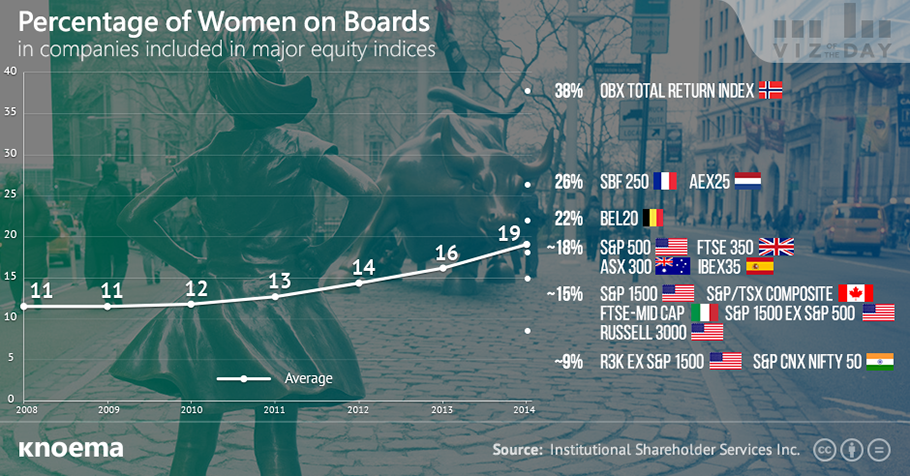Gender Diversity and Corporate Boards: A Review of Global Trends
АрхивIt will of course require more than a bronzed statue of a strong-willed girl taking on the bull of Wall Street to force a sustained and amplified role for women in the upper echelons of the corporate world. But, how far have we come globally in opening c-suites and corporate board rooms to women?
On average, during the period from 2008 to 2014, the participation rate of women on corporate boards increased in most of the publicly traded corporations included in major equity indices. Some notable differences emerge when accounting for gender quotas and industry trends:
- Markets with gender diversity quotas had a higher proportion of females on boards than those without mandatory quotas. Since 2011, the percentage of women on boards has risen by as much as 12 percent for companies in quota markets and only 3 percent in non-quota markets. Even among the worst preforming of the ranking, however, progress was evident. The companies on the Indian S&P CNX Nifty 50 increased female representation from 4.4 percent in 2008 to 8.3 percent in 2014.
- In quota-based markets, large capital firms had the highest proportion of women on boards and the largest increases in gender diversity. The strongest female representation in 2014 was among the companies of the Norwegian OBX Total Return Index, which reported 37.9 percent of board members were female.
- The household & personal products industry reported the highest female participation rate among corporate boards, while energy reported the lowest rate.
- The percentage of new female nominees to corporate boards almost doubled during the past seven years among US large-capital companies.
As the girl on Wall Street serves to renew interest and fervor over gender equality in the corporate world, we keep an eye on representation in government as well. Governments can further corporate-led initiatives with government-backed funding, programs, and legislation to enable progress on training opportunities, equal pay, and work-life balance to build and sustain female engagement in all levels of business. The devil is in the details—policies and regulations sort of details—but it is promising that as with corporate boards, during the last two decades, the share of women parliamentarians has doubled, increasing from 10.8 percent in 1997 to 21.2 percent in 2016.
Материалы по теме
Women in Parliament Around the Globe
Politics has long been considered as a 'man's world.' Even today, women remain significantly underrepresented in legislative and executive branches of government globally despite research that suggests a strong connection between women in leadership and economic and democratic gains.Today one-fifth of the world's parliamentarians and less than one quarter of national leaders are women. Rwanda, Cuba and Bolivia have the highest share of women parliamentarians, however, Europe has traditionally maintained the highest representation of women in government. As of June 2016, the ratio of men and women lawmakers in Belgium, Sweden, Finland, and...
Gender Imbalances and Female Foeticide
In 2014, Indian Prime Minister Narendra Modi announced a wide-sweeping reform and economic growth plan to address female foeticide in India under a campaign called, “Educate the Girl, Save the Girl”. Through the empowerment of women, Prime Minister Modi sought to stop female feoticide, a practice which has grown in India over the last few decades as fetus imaging technology to confirm the gender of the fetus has developed and become more broadly available. As a result, while the overall ratio of females to males (feminity ratio) in India has gradually improved, the ratio among newborn babies has deteriorated. In the mid-1970s, the ratio of...
2015-16 State of the Future | The Millennium Project
Global intelligence on the future of the world in the palm of your hand KurzweilAI News Date of Event: Wednesday, October 28, 2015 Description: The Center for Future Studies NEF of the Catholic University of Sao Paulo (PUC-SP), Brazilian Node of the Milennium Project, will be presenting the SOF. The Millennium Project connects futurists around the world to improve global foresight. It is now an independent non-profit global participatory think tank of futurists, scholars, business planners, and policy makers who work for international organizations, governments, corporations, NGOs, and universities. The Millennium Project...
The Global Gender Gap Index 2014
Gender inequality is still an acute problem in the modern world. It arises from differences in social, political and civil rights between men and women. This problem has existed since ancient times and remains urgent to the present. Nowadays fighters for women's rights has achieved notable progress. In many countries the differences in rights between men and women have become less noticeable. However, in some regions the women are still highly discriminated against.The presence and magnitude of gender inequality is evaluated by measuring the representation of men and of women in a range of roles. A number of international comparative gender...
